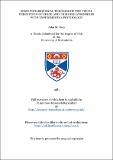Files in this item
Some philosophical theories of the visual perception of space and their relationships with experimental psychology
Item metadata
| dc.contributor.advisor | Quinault, F. C. | |
| dc.contributor.author | Gray, John M. | |
| dc.coverage.spatial | 185 p. | en_US |
| dc.date.accessioned | 2018-07-09T11:02:55Z | |
| dc.date.available | 2018-07-09T11:02:55Z | |
| dc.date.issued | 1981 | |
| dc.identifier.uri | https://hdl.handle.net/10023/15116 | |
| dc.description.abstract | Chapter One introduces the theory which is based on three postulates derived from pragmatism, empiricism and constructivism respectively. Veridical perception is seen not as reflecting the world as it is in some absolute sense, but as providing guidance for effective action. Its ability to do this depends on its relationship to active touch. This relies on their both being forms of action, i.e. they both consist of the operation of schemata which are at the same time guides for action and products of action. The second chapter relates how versions of these postulates have appeared, singly or in pairs, in previous theories especially those of Berkeley, Kant and Schelling. Then MacMurray's theory, which embodies all three postulates is introduced, and this is related to Gibson's theory. Chapter Three discusses how the key terms in the theory, image, percept and schema, relate to each other, and argues that they all reflect the same underlying psychological process. Chapter Four is concerned with dynamic and hedonic aspects, with how perception relates to motivation and feeling. Conventional theories see any such relation as external and associative while those based on perceptual schemata allow both external and internal relationships. These different sorts of theory are compared over a wide range of phenomena. Only the schemata based theory can account for all of the effects. Chapter Five starts with a brief discussion of the limitations of information processing type models in psychology, particularly with respect to dynamic aspects. With these in mind, it goes on to develop an outline model. Construction of the model draws attention to two important aspects of the theory; the non-existence of a pure metric representation and the lack of any strictly causal link between retinal stimulation and percept. Chapter Six examines the literature on adaptation to optical re-arrangement, a convenient method of studying the relationship between spatial vision and touch which is a key issue for the theory. While the crucial re-arrangement is impossible to produce, the weight of evidence supports the sort of theory proposed here. Chapter Seven compares this theory to others, particularly Neisser's, and suggests other areas of application in both visual perception and general psychology. | en_US |
| dc.language.iso | en | en_US |
| dc.publisher | University of St Andrews | |
| dc.subject.lcc | BF241.G8 | |
| dc.subject.lcsh | Visual perception | en |
| dc.title | Some philosophical theories of the visual perception of space and their relationships with experimental psychology | en_US |
| dc.type | Thesis | en_US |
| dc.type.qualificationlevel | Doctoral | en_US |
| dc.type.qualificationname | PhD Doctor of Philosophy | en_US |
| dc.publisher.institution | The University of St Andrews | en_US |
This item appears in the following Collection(s)
Items in the St Andrews Research Repository are protected by copyright, with all rights reserved, unless otherwise indicated.

